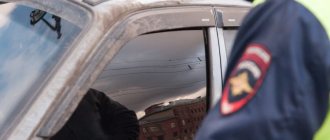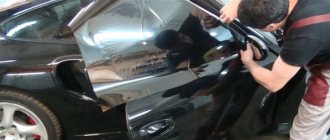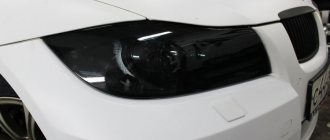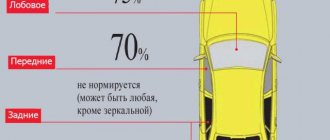For many, a car is not just a vehicle, but a separate world, so drivers strive to modernize the car to suit themselves and pay great attention to accessories and tuning elements. One of these is a tint film, which helps darken the standard windows and hide the interior from prying eyes. It has also gained popularity for the fact that it allows you to protect yourself from the bright sun and minimize the risk of fading of the upholstery inside the cabin. Drivers began using tinting back in the 80s. last century, and today it can be applied in almost any service. However, excessive tinting of windows on a personal car is prohibited in Russia, and in case of violation of the law, the traffic police inspector may issue a fine. They have fought against heavy tinting before, threatening arrest and confiscation of license plates, but today they are limited only to the imposition of administrative liability. You can find out what the fines for using tint film are in 2021 and whether it can be avoided by reading this article.
Content
- What tint is allowed?
- Acceptable glass tinting according to GOST
- Windshield tinting rules
- Acceptable tinting of the side windows of the first row
- Car rear window tinting
- Rules for tinting rear side windows
- Checking the car tint level
- Fines for illegal tinting
- How to avoid a fine for tinting your car windows?
- Questions and answers on the topic
What tint is allowed?
The light transmittance of the front and rear windows of a car is regulated by the requirements of GOST 32565-2013. This standard specifies the maximum percentage of shading for individual elements of the machine. In particular, the permitted tinting for the front and side windows of the car is indicated, and the size of the strip of color film applied to the top edge is determined. For violation of these requirements, the driver faces a fine established by part 1, clause 5, article 12 of the Code of Administrative Offenses of the Russian Federation.
If you decide to use car rear window tint film on your windshield or windshield, remember that elements with a mirror effect are completely prohibited. At the same time, GOST does not allow tinting or painting the windshield. The allowable reduction in light transmittance is provided to cover the difference created by the characteristics of the factory material.
Tinted front side windows according to GOST
On the territory of the Russian Federation, GOST 32565-2013 is in force, which came into force in 2015. This GOST legalized glass tinting using film: clause 4.2 states that safety car windows can be painted or tinted using paint or a polymer coating.
Permitted light transmission characteristics for car windows:
| Light transmittance of glass, which provides the driver with visibility from the front | 70% |
| Light transmittance of other glasses | Not standardized |
To avoid penalties for window tinting, the light transmittance of the front side windows must be at least 70%. Since most new cars now already have factory athermal tint, which transmits 80% of the light, the use of additional products is impractical.
But if you have a strong desire to tint your car, it is better to turn to professionals who will darken the glass without exceeding the permissible figures and check the result.
Important: even if the car does not have factory tinting, you should not think that its windows transmit 90% of the light.
Over time, the light transmittance of the material decreases, and for a used car it can be 80 percent or less.
There are several options for legal tinting of front windows:
- If the car does not have factory tint, you can use athermal film. It does not impair visibility even in rain and snow, but perfectly protects against heat and fading of the skin;
- a tinted strip can be applied to the top of the side windows to protect the driver and passenger’s eyes from the sun;
- Another acceptable option is electrochromic tinting. It is easy to adjust, which means you can always adjust the parameters you need.
Film "Chameleon"
Cars whose front side windows are completely tinted with chameleon film are very common on the road. Usually they are tinted in a circle, that is, all windows, windshield, rear and side, have the same opaque mirror surface, shimmering in different shades.
There is a film on sale, the manufacturer of which has fulfilled all the requirements according to GOST: the light transmittance of the lightest “86th” is 79%. Formally, if the glass throughput is 90%, such tinting is allowed. In practice, factory glass often has defects, and when measured, the device shows less than 70%.
It has been noticed that traffic police stop drivers of “chameleons” much more often than cars with simply colored or tinted windows.
When choosing a “chameleon” tint, you should carefully measure the result and be prepared to regularly communicate with representatives of the State Traffic Inspectorate. But lovers of stylish cars and tuning are not afraid of these risks.
Partial tinting
Many car owners are interested in the question of whether the fact that according to GOST it is necessary to comply with strict tinting standards only for those car windows that are necessary for visibility means that it is possible to partially tint the front windows.
After all, their second half is not actually used to monitor the road.
The answer to this question is negative: if a traffic police officer notices partial tinting of the front side door, he will issue a fine. The photo according to GOST shows that the entire side front glass must have a light transmittance of 70%.
Acceptable glass tinting according to GOST
Permitted tinting 2021 provides different levels of light transmission for individual car windows. When choosing film density, you need to remember the requirements of GOST, and also that even in a new car it is impossible to achieve 100 percent transparency. If the machine has been in operation for several years, then the light transmittance cannot exceed more than 90 percent.
Windshield tinting rules
According to the law, based on GOST requirements, car glass that provides forward visibility must have a light transmittance of at least 75 percent. The safety of the driver and passengers on the road, as well as the life and health of other road users, depends on this. GOST allows the use of a colored transparent strip on the windshield for protection from the bright sun. Its width should not be more than 14 cm.[1]
Acceptable tinting of the side windows of the first row
Permitted tinting of front windows in 2021 provides for at least 70 percent of light transmission. This means that darkening the sides is allowed no more than 30 percent.
Car rear window tinting
The law and the current version of GOST allow rear windows to be darkened, provided that external rear-view mirrors are installed on the sides of the car. In this case, the percentage of tint is not standardized. If the vehicle does not have mirrors, the light transmittance should remain at 70 percent.[2]
Rules for tinting rear side windows
GOST allows the use of tinting of any density on rear side windows. An important condition that must be observed when choosing a tint film for a car is that it should not have a mirror effect. This is not directly prohibited by the Code of Administrative Offenses of the Russian Federation, but is not permitted by the technical regulations of the Customs Union, adopted by all participating countries.[3]
Tinting car windows - tips from experienced people.
This post has 3 comments.
Car windows can be tinted for various reasons: some car owners do this to improve the appearance of the car, some apply tinted film in most cases in order to maintain their health and escape in the summer from the insatiable scorching rays of the sun. Whether to tint your car windows or not is up to you to decide, but we, in turn, want to outline a number of reasons why you should still tint your car windows (with your own hands or trust the service station masters).
Six reasons to choose car window tinting:
- — tinting primarily saves the car interior from overheating (heating is reduced by 60%), that is, the sun does not heat up the seat upholstery so much and passengers in the car, including the driver, are not so susceptible to heating through the windows.
- — the film for tinting itself is capable of blocking ultraviolet radiation harmful to humans; in percentage terms, the film blocks ultraviolet radiation by 99%, that is, people in cars with tinted windows are protected to the maximum from the harmful effects of the sun.
- — in the event of a possible collision, the film on the windows prevents the glass from shattering into many tiny sharp fragments, in other words, it is an additional protection that protects the driver and passenger during emergency situations.
- — tinting protects the driver’s eyes from the blinding headlights of oncoming cars; thanks to the film, the shine of the oncoming car itself is also muted.
- — tinted windows ideally mask everything that happens inside the cabin, that is, the driver and passengers are not subject to the close attention of prying eyes from the outside.
- — tinting protects the seat upholstery from fading.
Do-it-yourself car tinting - algorithm of actions.
It is correct to apply tint to the glass from the inside of the car, but if you glue the film on the outside, it can very soon begin to move away from the glass (rain, snow, frost, heat - all this renders the film unusable). The film, according to Russian GOST No. 5727-88, consists directly of film, a thin layer of paint and metal powder.
Gluing tint film to glass is a long and painstaking process. It is first necessary to thoroughly wash the glass; they should be washed with warm water and detergents. After washing, the glass needs to be degreased. These procedures help to thoroughly clean the glass and prepare it for film application. If there is sputtering or convex tubercles on the glass, the film will not lie as we would like (clearly and smoothly). Also, if a navigator (phone holder) is attached to the glass, you will have to remove it or try to get around it.
It is quite difficult to apply tint film to the rear window of a car on your own, without the necessary equipment and tools, especially if the glass has heated glass or a brake light. Here, as they say, it is better to entrust the matter to professionals and not waste your time.
Ideally, you should first remove the glass, which is what specialists at service stations do, but doing this yourself is quite problematic, so you can get by with patterns made from thin papyrus paper. The paper is placed on the glass (you can wet it) and a contour is outlined, then the contour is carefully cut out and therefore the required tint size is cut out to the finished pattern.
Before you start gluing the film, generously moisten the inside of the glass with soapy water; it is advisable to hold the film itself with your fingers by the edges; if you grab the middle, the film instantly wrinkles. The tint sticks to wet glass without any problems; you can smooth out the film and remove bubbles with a piece of cloth folded several times or a towel.
It is recommended to apply an adhesive solution along the very edge of the glass; this is done last, when the tinting has perfectly sat down, after which the edges are carefully smoothed. This is done so that over time the edges of the tint do not begin to move away from the glass. Excess adhesive solution can always be removed with a dry cloth. You can also use a napkin (towel) to squeeze out small air bubbles, moving them to the edges of the glass.
Is it possible to apply tint in cold weather?
Yes, it is possible, but only if the gluing process is carried out in a well-heated box, the temperature in which will be above +10 degrees Celsius. We explain why exactly +10: the process of gluing tint on glass involves using a hairdryer, it heats the film, makes it pliable, and under the influence of temperature the film completely adheres to the glass, repeating its curves. The hairdryer supplies air heated to 600 - 900 degrees Celsius, and if the air temperature in the repair box is low, the glass will simply crack due to the temperature difference.
If you nevertheless decide to do tinting in winter and make sure that the operating temperature in the box is above ten degrees, remember that you cannot go out into the cold for the first two days, and you also cannot lower the windows on which the film is glued. It is possible and recommended to warm up the interior of the car; this will speed up the polymerization process of the adhesive applied to the film. The first two days after applying the tint in winter, the car should be parked in a warm box. If you allow a difference in air temperature, cracks or small bubbles will appear on the film.
Electronic car window tinting
Electronic tinting is a smart glass, it has three layers: the two outer layers are glass, and the middle layer is made of liquid crystals. It protects against UV radiation by 85%, regardless of the degree of shading of the glass. Current consumption is only 7 W per 1 sq. smart glass meter. Controlling smart glass is simple; just select the desired dimming option for a specific glass on the remote control. Electronic tinting is popular in European countries; most expensive cars already come with it as standard. It is almost impossible to install smart glass on your own, since you need experienced craftsmen and special equipment.
The convenience of electronic tinting is that each glass can be darkened individually. In the hottest weather, the car windows can be completely darkened, this will reduce the heating of the interior. Tinting can reduce the visibility of the interior from the outside to zero, and when driving towards the rising or setting sun, the driver can increase the tinting of the windshield, which makes the trip more comfortable for the driver’s eyes.
Checking the car tint level
To measure the light transmission of side windows, rear or front windows, traffic police inspectors use special certified instruments. At the same time, the GOST requirements do not specify any requirements for the environmental conditions under which the percentage of density of the tint film can be checked[4]. In fact, this document allows the traffic police officer to take measurements even in a downpour, and at the same time his actions will remain within the law. The readings from the device for checking tinting are entered into the protocol by the traffic police officer. Without compliance with this requirement, no fine can be imposed for violating GOST rules. During the inspection, the driver has the right to ask the employee for a certificate for the device. It is important to ensure that no films or other elements are attached to the sensors when taking measurements. If the driver does not agree with the results of checking the level of tinting of the front or side window on his car, he can ask the employee to re-analyze the percentage of light transmittance in the presence of two witnesses. [5] In a garage environment, it is also possible to determine the approximate percentage of light transmittance. To do this, you need to know the density of the film and the condition of the car glass itself. As a check, the light transmission coefficients of these elements are multiplied and divided by 100 percent. Example: 75*90/100 = 67.5 - permitted tinting for rear windows. You can learn how light transmittance is checked in practice from this video:
What is said about tinting?
Tourist bus
What does a tourist bus have to do with it?
In the traffic rules, the light transmission of windows (tinting) is regulated by the Basic Provisions for the admission of vehicles to operation in paragraph 7.3 of the appendix with a list of faults for which the operation of vehicles is prohibited . Compare the current edition and the edition in the project:
Current:
7.3. Additional objects have been installed or coatings have been applied that restrict visibility from the driver's seat.
Note.
Transparent colored films can be attached to the top of the windshield of cars and buses. It is allowed to use tinted glass (except for mirror glass), the light transmission of which complies with GOST 5727-88 . It is allowed to use curtains on the windows of tourist buses, as well as blinds and curtains on the rear windows of passenger cars if there are external rear-view mirrors on both sides.
Project:
7.3. Additional items have been installed or coatings have been applied that limit visibility from the driver’s seat; the light transmission of the glass does not comply with GOST 33997-2016 .
Note. Curtains are allowed on the side and rear windows of vehicles of category M3 class III.
As you can see, changes regarding vehicle tinting are of a formal nature . The link to GOST has been changed. According to GOST 33997-2016, the permissible light transmittance is 70%, in contrast to GOST 5727-88, in which the tolerance is 75%. But this is not of fundamental importance.
The category of vehicles where curtains are allowed is indicated - these are the same tourist buses.
Category M3 - Vehicles used for the transport of passengers, having, in addition to the driver's seat, more than eight seats, the technically permissible maximum weight of which exceeds 5 tons.
Class III , designed to carry exclusively seated passengers.
Thus, for most drivers, the changes will only affect the change in permissible light transmittance from 75% to 70%.
Fines for illegal tinting
If during the inspection it turns out that the darkening of the windows on the car exceeds the percentages established by law and GOST, the traffic police officer can issue an official report. The fine for illegal use of tinting is 500 rubles.[6] If the driver has already been caught violating GOST requirements, paid the issued fine, but did not remove the tint film, the traffic police officer has the right to issue a protocol for a new penalty in the amount of the same 500 rubles.
How to avoid a fine for tinting your car windows?
If, during the inspection, the traffic police inspector imposed a fine on the driver of the car for excessive darkening of the standard windows, this order, like any other, can be appealed in the standard manner provided for by the current law. However, it is worth remembering that to check light transmission, traffic police officers use a special device that has passed the appropriate certification. Therefore, it is almost impossible to prove to higher authorities that the equipment incorrectly determined the degree of darkness. If you were stopped by a traffic police inspector and during the inspection discovered a violation of GOST requirements regarding window tinting, you need to get rid of the tint film. By doing this immediately on the spot, you can even avoid an unwanted fine. To remove the tinting from the windshield, rear standard glass or side windows yourself, as directed by the traffic police officer, just pick up its edge and pull it up. The canvas should move away from the surface. If the tint film is of poor quality or has been glued to the glass for a long time, pieces of it or glue residue may remain on them. You can get rid of such defects using a soap solution and a special blade. Therefore, if you are not sure that you can quickly and easily remove the tint film from the rear or front standard windows on your own, it is better to contact a specialized service. There is a legal period of 10 days for this. If the tinting is done by spraying, then getting rid of it will be even more difficult. In this case, all glass that is not darkened according to the rules must be completely replaced. You will learn how to remove the tint film yourself from this video:
Questions and answers on the topic
Is tinting allowed in Russia?
Excessive tinting of car windows is illegal. The permissible percentages of light transmittance are reflected in GOST. Dimming the front window and side windows is permitted only within the prescribed values.
Do all types of glass have the same tinting requirements?
GOST adopted by law establishes different levels of minimum light transmission. For example, the shading of the front side windows should not be higher than 30 percent, and for the second row the shading level is not regulated at all.
What is the fine for tinting in 2021?
If a traffic police inspector during an inspection reveals that the permissible percentage of light transmittance is exceeded and does not comply with GOST adopted by law, the officer has the right to issue a fine in the amount of 500 rubles.
How to determine the level of tint?
To check the percentage of light transmittance, the traffic police inspector uses special certified devices according to the methodology described in GOST. It is more difficult to independently calculate the degree of tinting, but you can use a simple formula in which the light transmittance coefficients of glass and film are multiplied.
Two layer tinting
The two-layer tinting procedure has gained great demand among car owners in recent years. But most Russian companies do the wrapping incorrectly, as a result of which the side, rear and sometimes windshield windows end up completely tinted. However, this is a violation of safety regulations.
Features and types of two-layer tinting
There are a number of ways to achieve two-layer tinting.
Application over old film
Sometimes the owner of a car wants to update its appearance. To do this, it is not necessary to remove the old coating. In some cases, a new film is applied directly on top of the old one, which must be in satisfactory condition - without peeling parts, scratches or clouding. This solution will save on dismantling. Specialists need to ensure that the darkening is not too strong and does not contradict GOST.
Application over a sprayed layer
Spraying is an expensive procedure. It is almost impossible to remove. To update the tint, gluing is carried out on an existing layer. There are no disadvantages in this situation. It is enough to follow the rules regarding the general level of darkening and adhere to the gluing technology.
Achieving a special effect through two-layer tinting
To achieve a special effect, various films that have certain properties are combined. This can be an athermal material that reduces the degree of heating of the interior and a metallized film that reflects radiation.
Along with functional characteristics, aesthetic indicators are also taken into account. Sometimes it is possible to achieve unusual tints or new shades. It should be noted that it is not necessary to use two films for this purpose, since the modern assortment includes tinting materials that meet all the requirements.
Compliance with conditions when tinting in two layers
- Light transmittance level. There are state standards for window tinting. For side windows, the light transmission rate is 70%, for the windshield - 75%. When choosing a film, you need to ensure that the first layer on the side windows leaves 80% of light transmittance, and the second – 90%.
- Distortion of shades. There must be good visibility on the road, so films cannot distort the colors, dimensions and other indicators of objects.
- Presence of damage on old material. If the previous layer includes abrasions, scratches and various defects, gluing a new film over it will be pointless. You must first remove the old tint, clean the glass and apply a new coating.
Our Llumar Tinting Center employs experienced employees who can handle the dismantling of old materials and the application of new tinting in accordance with your preferences. We use only high-quality films from American manufacturers Llumar, as well as ASWF. Specialists strictly follow the gluing technology, due to which they manage to achieve an impeccable result.











